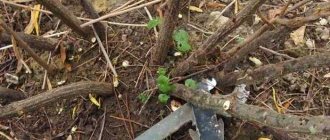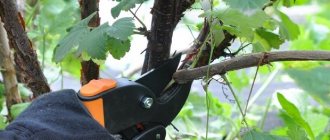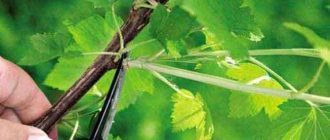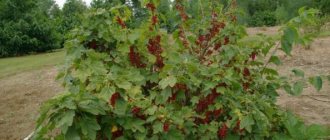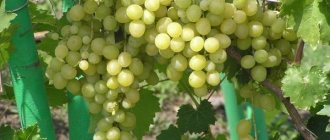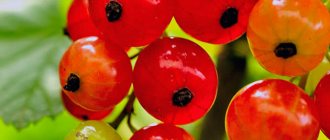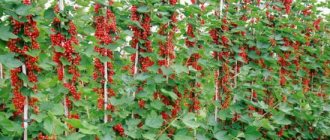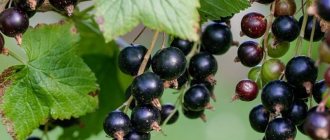Geography of the variety
The Rowada currant variety was bred at the Netherlands Agricultural Plant Breeding Institute in the 80s of the last century. As a result of the work carried out, a variety was obtained for cultivation in regions with a temperate continental climate, without sudden temperature changes between winter and summer. Thus, it is not suitable for cultivation in the Urals, in the northwestern regions of Russia and the northeastern regions of Ukraine: these places are characterized by hot summers and severe frosts in winter.
Did you know? Russia ranks first in the world in currant cultivation.
Rowada without notes for the gardener and farmer
Red Rowada - description, characteristics
Bred by LM Wassenaar in the Netherlands in 1980, Institute of Crop Breeding, Wageningen. Parent varieties Fat Prolific x Heinemann Rote Spatlese. A valuable variety for commercial cultivation and processing, and for amateur gardening.
Mid-late ripening - ripens in the third ten days of June - the first ten days of July, depending on the region. The fruiting period is extended to 1.5 months. Due to late flowering, it is not subject to spring return frosts. It has good pollination - there are practically no barren flowers.
Industrial yield is about 35 t/ha, yield per bush is 7-10 kg (per adult, more than 4 years with high agricultural technology, proper pruning, bush shaping).
The berries are large, up to 0.6 g. The fruits are collected in very dense clusters from 10-12 to 20 cm long. The berries are stored on the bushes for a long time on strong and hard stalks, without falling off.
- The bush is vigorous, up to 1-1.75 m high, the habit is dense, medium spreading. The shoots are thick, intensively branched, very strong, with powerful growth force.
- The leaf is five-lobed, large, dense, wrinkled, dark green, densely pubescent below. The middle lobe is elongated, the lateral lobes are sharp and shortened. The base is straight.
- The number of fruits is about 25-30 pieces.
- The average weight is 0.6-0.7 g, some specimens are higher. The berries are red, dark red when fully ripe, uniformly large, sweet and sour, with the typical taste of red currants (Ukrainian porichki). According to reviews, they are stored without loss of quality at a temperature of +1...+2 C for about 2 weeks.
- Winter hardiness is high, up to -34 C (frost resistance zone 4).
- Moderate sensitivity to anthracnose. Resistant to mildew, powdery mildew, rust and other diseases.
- Reproduction: propagated by dividing the bush, green cuttings, vertical and horizontal layering. For vertical layering, the bush is bent in the spring to the ground level, and young shoots are spudded in July. In autumn, young shoots are planted in the nursery.
From reviews: as alternatives, you can consider the following varieties with similar brush length and yield. They will also be a priority due to the fact that they are zoned for the climate of Russia, Ukraine, and Belarus. So, it is worth looking towards Rondom, Svyatomykhailovskaya, Samburskaya, Orlovskaya zvezda and other, no less worthy varieties of Russian and Ukrainian selection.
Myths about advantages and disadvantages
- High yield - due to high productivity, it is grown on commercial areas in Holland, Great Britain, Poland, Russia, and Ukraine;
- Long clusters, good fruit quality;
- Sweet and sour taste with a dominant sourness - to put it simply, it is sour (many call this taste the classic taste of red currant);
- Prone to thickening - proper shaping is necessary so that the fruits do not become smaller, so that the plant’s forces are not directed at maintaining the growth of the above-ground part;
- In regions with a harsh continental climate, it will not reveal all its undoubtedly high qualities: it does not tolerate high summer temperatures, and if winter temperatures are too low, falls without sufficient snow are possible. Thus, it does not always perform well in the north-east of Ukraine, and not too well in the Urals, in the North-Western regions of Russia. In this case, it is advisable to look towards alternative options, zoned for these regions, but with similar indicators - fortunately, there are many of them.
- Under equal conditions, cuttings take root many times worse than black varieties - like many red-fruited ones, however. When cuttings are taken in August (late August - early September), the survival rate increases.
The first myth: without additional effort - a gigantic harvest. Let's dispel it: without advanced agricultural technology, including pruning, which has its own characteristics and is fundamentally different from old low-growing bushes, you can only get a regular harvest, low, medium-sized, scattered berries. So, by forming on a trunk, you can increase both the yield and the length of the cluster. This also applies to the size of the fruits: without rationing, pruning and sufficient fertilizer, they will be slightly larger than usual.
Second: high heat resistance. Based on personal opinion and experience: they have nowhere to get the culture bred in foggy and damp Scotland - it is not zoned for them. It is difficult to imagine that the variety was bred taking into account the climate of northeastern Ukraine or Samara, Astrakhan and Kazakhstan. For the southern regions, where the problem of lunges calls into question the advisability of planting red currants in general, not only Rovada, you can consider analogues zoned for these regions - according to reviews, this will be the best option for the gardener.
Third: you won't find anything better. This is what those who have revealed all its advantages think so thanks to their high skill and high agricultural technology. It’s hard to say that they are wrong – but there are analogues, and not so few. Direct hands capable of realizing the inherent potential - there just aren’t very many of them, alas, forgive the author’s liberties.
Care: planting, pruning, feeding and mulching
Traditionally planted in well-lit areas, in the south it thrives in partial shade. The best time for planting seedlings is August - early September. Seedlings are planted in rows with a distance of at least 1.5 m between plants and 2.5-3 m between rows.
- It will not tolerate waterlogging of the soil, despite the moisture-loving nature of the crop, and does not like heavy, clayey soils. It takes root well on well-slightly acidic, light, sandy loam and medium loamy soils.
- When planting, the seedling is tilted at an angle and buried 6-7 cm above the root collar.
- As the bush grows, it first forms 2 shoots, then 4. In the third year it needs thinning. Since second-order branches grow very quickly, it requires frequent pruning compared to other varieties.
Pruning: often grown on a standard, when the branches of the lower tiers are cut off - it is with standard molding that the variety gives the best yield indicators due to the lack of thickening, the fruits retain their size, and the brush retains their length. In commercial berry gardens, such molding will not only increase yields and reduce planting distances, but will also make harvesting much easier.
About 2 shoots are left annually. Pruning of old growth begins at 4 years of age. By 5-6 years old, the bushes can be considered mature: there should be about 7-9 shoots of different ages.
If you prune more and earlier, you will harvest more: this is the principle of pruning Rowada, which is prone to intensive growth. If overloaded, it is possible to crush the fruits - the brushes will be short if there are a large number of them. Some begin to rejuvenate after the 3rd year of fruiting: as you know, most of the harvest is concentrated mainly on the growth of the previous year.
It is useful to mulch the root zone - the risk of overheating of the roots is lower, and the moisture and looseness of the soil will remain. In early spring, nitrogen fertilizing (saltpeter, urea) is necessary; during flowering and ovary, a mineral complex is relevant, including potassium, phosphorus, calcium, etc. In autumn, it is useful to mulch the root circle with humus.
Reviews
The Rovada red currant collected mostly positive opinions and reviews: the length of the brushes, the abundance of clusters on the branches, powerful bushes, growth rate and abundant branching amaze. However, the intense growth force has also become a reason for negative reviews: for those starting to get acquainted with pruning at first, it is difficult to grasp the principle of manipulation; for those starting to get acquainted directly with the variety, it is difficult to imagine all its power of development: a real jungle can grow in 3-4 years without rationing!
Botanical description
The Rowada variety has the following botanical features:
- the bush is strong or medium-sized;
- replacement shoots are strong, powerful, with great growth force and about 170 cm long;
- the leaves are a rich dark green color, the leaf blade is dense, wrinkled, with an oblong middle and short side parts with pointed teeth;
- flowering is later, barren flowers are absent, the ovary is almost 100%;
- berries of a rich red color, with shine and thick skin;
- the brushes are elongated, approximately 10–20 cm long, about 20–25 berries are formed on them.
Description of the red currant variety Beloved
Currant variety Beloved is characterized as a low-growing, compact bush. It has medium growth vigor. The crown is irregularly rounded. It has slightly spreading branches. During the fruiting period, the branches are dotted with berry clusters. On arched racemes that grow downward, bright red clusters of large berries are densely located. The fruit clusters are very dense, cylindrical in shape and medium in size.
The shrub produces young, large, straight, hairless shoots that look quite thick, hard and even. They form medium-sized buds of an oblong oval shape. The kidneys are slightly deviated. The wood is painted green with a lightened center. The bark of old branches takes on a gray tint. And young shoots are red in color.
The clusters reach a length of about 7 cm, and each cluster contains about 12–14 berries.
The leaves of the bush are not particularly large, reminiscent of maple. The leaf blade is quite rough, not glossy, jagged with blunt edges, divided into 5 lobes. The leaf color is dark green matte. The inflorescences are a very delicate blue shade, with yellow-green sepals. The flowers have reddish streaks. Flowers bloom in early May. The color fades by the end of the month.
Characteristic
A mid-late ripening variety. The fruits are beautiful red in color, with shine and elastic skin. The pulp is juicy and dense. Ripe clusters do not fall off and hold tightly to the bush. The harvested crop is stored for a long time and is well transported.
Drought resistance, frost resistance
Rowada is noted for its good frost resistance, according to the originator’s request - down to –34°C. Tolerates dry periods well.
Read about the Ataman variety of currants.
Productivity and fruiting
The yield of the described plant is high: with proper agricultural technology - 10 or more kilograms per bush, on an industrial scale - about 35 tons per hectare.
A full harvest can be harvested at the end of June - beginning of July: it all depends on the region and weather conditions. Fruiting lasts up to 35–45 days.
Berry size, taste
The berries taste with a pronounced sourness, characteristic of red currants, with a pleasant aroma. The fruits are large, weighing up to 1.5 g.
Advantages and disadvantages
- Advantages of the Rowada variety:
- high productivity;
- late flowering period, which protects flowers from spring frosts;
- excellent quality of berries;
- pronounced currant sweet and sour taste of the fruit;
- disease resistance.
- But there are also disadvantages:
- increased sensitivity to sudden changes in continental climate;
- strong growth of replacement shoots - this complicates the care of the bush, since more frequent and careful pruning of excess branches is needed;
- Compared with black currant, poor survival of cuttings.
Positive and negative sides
Red currant Beloved
Each plant variety has its own advantages and disadvantages. Positive aspects of Rovada red currant:
- Great fruitfulness. Used commercially in Norway, Russia, Poland, Ukraine and the UK;
- High quality berries, suitable length of bunches;
- Pleasant sweet and sour taste and presentable appearance;
- The beneficial properties of the fruit are used not only for culinary, but also for medicinal purposes.
Negative sides:
- The branches grow quickly, which leads to thickening. Constant supervision and proper training are required;
- It reproduces much worse than other varieties of currants. Cuttings of black varieties take root and take root better. This is a problem with any type of red currant;
- It is susceptible to parasites and aphids, but with timely treatment this deficiency is easily eliminated.
So, Rowada is a very productive and presentable variety of red currant. With proper planting of seedlings, processing and shaping, the currant bush will bear fruit abundantly for twenty years.
Landing Features
Rowada is considered not a particularly demanding variety. For planting, you need to take into account some features regarding the selection of location and soil quality. It is also worth choosing and planting seedlings correctly.
Find out where to plant currants - in the shade or in the sun.
Deadlines
Planting can be done either in late August - early September, or in early spring. But experienced gardeners still advise doing this in the fall: this way the plant will have more time to adapt and take good root.
Choosing a suitable location
Rowada currants need sunlight in the morning, and partial shade at lunchtime. The place should be protected from cold winds. This can be a flat or slightly sloping area. The groundwater level must be at least 150 cm from the surface.
The variety is not very picky about soil, but preference should be given to soil with moderate or neutral acidity - the bush does not grow on clay soils.
Find out how to transplant currants to a new location in the fall.
The site must be prepared in advance:
- dig at least enough for a spade bayonet;
- get rid of weeds and their roots;
- add the necessary fertilizing - humus, superphosphate and wood ash or potassium salt;
- If necessary, you need to correct the acidity of the soil.
Selection and preparation of seedlings
Planting material must be purchased from trusted sellers with good reviews. You should not buy seedlings at spontaneous markets. But if it is not possible to visit a specialized farm and the choice is left to private owners, ask the seller as many specific questions as possible about the variety - where the seedlings grew, how to plant correctly, what to feed the planting, etc. If the seller is nervous and does not know the answers, such purchases should be abandoned.
Did you know? Externally, black and red currant seedlings do not differ.
To check which one is in front of you, rub the shoot with your fingers: black currants will have a characteristic smell, but red ones
will
not.
A high-quality seedling must have the following characteristics:
- the presence of at least 3 elastic light shoots, 2-3 buds;
- height - at least 15 cm;
- not swollen kidneys;
- the root system is developed and consists of several skeletal processes about 20 cm long and many thin ones;
- wet roots - a conscientious seller will definitely moisten them with a mixture of clay or earth with water.
Landing algorithm
To plant red currants, planting holes must be dug 10–15 days before the start of work. They should be 40–50 cm deep and 40 cm in diameter. The distance between bushes is at least 70 cm, between rows - 100–150 cm.
The dug soil must be mixed with humus (9–10 kg), superphosphate (about 200 g) and wood ash (40–50 g) - this will be the planting substrate.
Important! If you purchased
seedlings with a closed root system, then the container must be lowered into a container of water, wait until the bubbles disappear and carefully remove the roots.
Description of the process of planting seedlings:
- Fill the holes halfway with substrate.
- Pour water over it and wait until it is absorbed.
- Place the seedling in the ground at an angle of 40°, sprinkle it with substrate, shake it slightly so that it is distributed among all the roots.
- Then fill the hole with earth and compact it well.
- The root neck should be recessed by approximately 5 cm.
- Make a circle around the trunk with a side, carefully water it so as not to free the neck from the ground.
- Apply a mulching (protective) layer of peat, humus, straw, sawdust, etc. - about 5 cm high.
- After planting, the stems must be trimmed, leaving 2-3 buds and approximately 10 cm in length.
- For prevention, it is recommended to spray the planting with Bordeaux mixture.
Currant Rowada
The bright red, spectacular necklace of Rowada currant berries, combined with the rich, rich color of the green bush, undoubtedly attracts the close attention of many gardeners. It is this variety that has become the most popular in European countries, and almost all over the world.
Currant Rowada was a successful development by scientists at the Institute of Agricultural Plant Breeding in the Netherlands (1980). Since then, it has been actively grown both for commercial purposes and for amateur consumption. This variety, according to experts, is superior in its characteristics to almost all other similar red varieties.
- 1 External signs
- 2 Landing
- 3 Care
External signs
Rowada is a medium-sized, medium-spreading shrub with fairly powerful, branched shoots. The average height of the bush is about 1 meter and above.
The castings are large, dense, dark green in color. The leaf blade is five-lobed, wrinkled. Moreover, the middle blade is longer in comparison with the sharp side ones. The lower surface of the leaf is densely pubescent.
Beautiful, firm, rich red berries are collected in large, elongated clusters. The surface of even fruits is smooth and shiny in the sun. One bunch contains compactly collected from 16 to 20 or more large round berries.
This characteristic feature of Rowada currants attracts many gardeners who grow berries for sale.
The taste of the berries is traditional for red currants - sour, but with the presence of sweet notes.
Varietal characteristics
The yield of Rowad currants is beyond praise. This is another of the indisputable advantages of this variety.
From one bush, with good care, you can collect from 7 to 10 kg of berries, and with industrial cultivation - up to 35 tons per hectare.
Late ripening variety. The flowering phase occurs quite late, when spring frosts are already unlikely. The fruiting period itself is quite long - it takes about a month and a half. The first fruits may appear by the end of July. Their ripening time depends on the growing region. The variety's pollination rate is good. Barren flowers are almost not observed.
The winter hardiness of Rowada currants is at a high level. The plant can withstand temperatures down to minus 30-34 degrees.
Resistant to many garden diseases, but sensitive to anthracnose.
Landing
Currants prefer well-lit and moist places far from groundwater (at least a meter). It is advisable that the planting be protected from cold winds and drafts. To get a good harvest, you must adhere to the following planting pattern: 2 meters between the rows and 1.5 meters between the plants themselves.
Planting is usually carried out in autumn or early spring. Well-drained, slightly acidic, loamy or sandy soils are suitable for growing red currants.
This currant variety propagates on the site in several ways:
- dividing the bush;
– green cuttings;
- layering.
Before planting seedlings, the root system of each bush must be inspected, diseased and damaged parts must be removed, and then soaked in water for 3-5 hours. When planting in the ground, the rhizomes must be completely placed in the planting hole.
This will help retain moisture in the soil and promote better bush growth.
Care
Rowada is not too whimsical. However, if a gardener is interested in getting a good harvest, then he must spend some effort caring for the plant after planting. This means regular watering, loosening and fertilizing the soil around the bush.
Pruning Rowada currants has several features. This fruit bush is prone to thickening, so its shaping is simply necessary. At the beginning of the development of the bush, 2 shoots are formed, then 4 shoots are left.
And in the 3rd year the shrub needs thinning due to the very intensive growth of second-order shoots compared to other varieties. Old growth begins to be pruned from the fourth year.
Due to the abundant yield, Rowada currant bushes need staking.
The Rowada variety is rightfully considered one of the most popular, especially for cultivation and further processing on an industrial scale. For amateur gardeners, just 3-4 bushes of such currants on a plot are enough to provide the needs of your family with a bountiful harvest of beautiful, tasty berries.
Care
Immediately after planting, it is necessary to maintain soil moisture, loosen the soil and remove weeds in a timely manner.
Sanitary pruning of young plants should be carried out - remove broken and dry branches, remove weak shoots.
The formation of the bush begins when the bush is three years old. It is necessary to cut off all weak branches and leave 5-7 strong healthy branches. Crooked branches and those lying on the ground should be removed, and excess root growth should be cut down.
Learn how to care for red currants.
In the future, there is no need to carry out particularly complex manipulations - everything is the same as when caring for other fruit and berry crops:
- in bushes older than 4-5 years old branches are removed that either do not bear fruit at all or produce few berries;
- Organic additives are added to the soil in the fall, and nitrogen fertilizers are applied in the spring;
- Water thoroughly during fruit ripening, as well as during drought. When flowering, watering is reduced. The procedure is carried out in the evening, liberally at the root and on top of the entire plant;
- the soil in the tree trunk circle is loosened, preventing the formation of a crust;
- to protect the roots from drying out and make it easier to care for the plant, the soil around the bush is mulched;
- weeds are removed - you can leave the plucked grass under the bush, which will create an additional mulch layer.
Preparing for winter
Bushes must be prepared for winter in late autumn, before the first frost. Before this, they gain strength for the next year, and it is not recommended to touch them.
Important! Main
-
do not miss the moment and remove the insulation in time, otherwise the plant will sweat, and the buds may rot from moisture and heat.
It is better to do this after the snow has melted. Preparation for winter proceeds as follows:
- To begin with, they prune the bushes, remove everything dry, weak, and with signs of disease.
- All vegetation, leaves, branches, berries, as well as the old layer of mulch are removed from the ground.
- The soil is carefully loosened, the necessary fertilizing is applied, watered well and new mulch is laid in a layer of at least 10 cm (in winter, manure can be used as mulch).
- The branches remaining for the winter are carefully collected into a bundle and tied - this will make it easier to cover the bush.
- They carry out preventive treatments against pests and diseases, or simply spray the plant with Bordeaux mixture or copper sulfate.
- Then the plant is insulated with any material convenient for the gardener that allows air to pass through. In regions with severe frosts, the bush is wrapped in several layers.
- You can dig a trench near the bush, bend and lay branches in it and sprinkle with a layer of soft, loose earth.
Shelter for the winter
Rowada is frost-resistant, but if in winter the temperature drops below 30-35⁰, then the plant will need additional frost protection. There are two ways to cover currants for the winter:
- Dig small trenches next to the bush and place the bushes there, sprinkling them with a layer of well-loosened soil.
- Bend the shoots to the ground and cover with breathable thermal insulation. For example, mineral wool is suitable. Film and similar materials cannot be used without it; the plant must breathe, otherwise it will rot.
The shelter should be removed with the first thaw. If delayed, the plant will later go into growth and active vegetation, which will ultimately lead to a drop in yield.
Reproduction methods
To preserve varietal characteristics and to avoid contamination of the planting with diseased planting material, Rowada currants are propagated by cuttings or layering, as well as by dividing the mother bush.
Read why currant branches dry out.
You can propagate currants from both green and woody cuttings.
Propagation by green cuttings begins during the period of active growth of branches, that is, in June. The sequence is as follows:
- The young shoot is cut off with part of the uterine branch.
- Then it is cut off, leaving the uterine part of the branch approximately 4 cm long, and the shoot itself must be at least 5 cm long.
- Next, remove the leaves that interfere with planting.
- The prepared cuttings are planted in such a way that the uterine branch is located horizontally. It should be deepened by 4–5 cm, and the young green shoot should be above the ground in a vertical position.
- There should be a distance of at least 10 cm between future plants.
- Then the planting must be carefully watered.
- After water is absorbed, the ground is mulched with peat or humus.
- Immediately after planting, the seedlings are watered every day, after rooting - once every two days, then - as needed.
- In the summer, future bushes need to be protected from strong exposure to the sun, and in the winter, care should be taken to provide shelter.
- The seedlings are transferred to a permanent place after a year.
It is necessary to propagate currants from woody cuttings in early autumn, that is, in early September. For this method you need:
- Choose healthy, strong branches and trim them from the bush.
- Remove all leaves, divide the material into cuttings, leaving 4 buds on each. Moreover, the upper adrenal section should be smooth, and the lower one, which is under the kidney, should be oblique.
- Next, the harvested seedlings are dipped into a solution with a drug to stimulate growth - with an oblique cut downwards, for 10-12 hours.
- Afterwards, the prepared bed must be covered with plastic film with holes made in it at a distance of 10–15 cm.
- Then place the cuttings into the holes at an angle of 40°, burying two buds in the ground and leaving two above it.
- Next, the seedlings are watered, protected from the sun, and insulated for the winter.
- The plants are replanted next spring.
With the onset of spring warmth, you can begin to propagate red currants by layering. The method is quite simple:
- It is necessary to choose the most productive bush, select two-year-old strong shoots from all its sides.
- Make trenches about 10 cm deep.
- Carefully place the branches in them, attach the shoots with pins, sprinkle a little with loose, damp soil, and leave the tops of the shoots on the surface.
- When the young shoots reach 10 cm in length, the cuttings must be completely covered with earth.
- During the summer, when the shoots grow, they need to be covered with earth several more times.
- It is necessary to monitor the moisture and looseness of the soil.
- In the last ten days of September, the branches are separated from the mother bush, carefully so as not to damage the young growth.
- Then the formed cuttings are cut off and transplanted to a permanent place. If the cuttings are weak, they grow them for another year and only then replant them.
Does the bush need pollinators?
The Rowada variety shows almost 100% ovary, barren flowers are practically absent: this is embedded in its genetics by the breeders. For these reasons, the plant, unlike other varieties of red currants, does not need additional pollinating plants.
The best varieties of blackcurrant
The culture is rich in varieties. They are divided into large, sweet, early, late, etc. Each summer resident will be able to choose the appropriate variety for the climate and region in which he lives.
Large varieties
Large black currants are famous for their fruit diameter of about 1.5-1.7 cm. Some berries reach large sizes.
The largest variety is considered to be bred in Siberia under the name Yadrenaya. The berries reach 7-8 g, the first harvest can be obtained in early summer. The only negative is that the variety is not suitable for growing in the south; the berries become smaller and acquire a sour taste. The plant needs constant reproduction.
Other large varieties:
- Dobrynya.
- Comfort.
- Sanyuta.
- The beauty of Lvov.
- Chereshnevaya.
- Anniversary Digging.
Sweet varieties
This type of crop is considered sugar. The fruits contain a huge amount of sweetness, pectin microelements, minerals and vitamins.
The best sweet varieties:
- Bagheera. The amount of sugar is 10.8%. The berries are not small and are suitable for creating various preserves. The harvest retains its presentation during transportation.
- Green haze. The amount of sugar is 10.2%, sometimes reaching 12%. The fruit size is medium to large. The fruits are used to make jelly and jam.
- Nina. The amount of sugar is 11%. The harvest is large, the bushes are of medium size. The fruits are nutritious and healthy.
- An excellent pupil. The amount of sugar is 11.1%. Charcoal fruits with sourness. The variety cannot boast of strong immunity; it often gets sick and is attacked by insects.
- Triton. The amount of sugar is 10.6%. The variety is intended for cultivation in the northern regions.
Early varieties
The most popular early varieties are:
- Litvinovskaya. Universal purpose, the plant grows tall. The fruit weighs about 3-4 g, with quality care it can reach 5 g. You can get about 2 kg of harvest from one plant. Litvinovskaya grows well in the Moscow region. The main disadvantage is that it does not tolerate heat.
- Gift of Smolyaninova. You can harvest 3 kg of berries from one plant. The plants are small. It has strong immunity and does not require pollinators. The variety performs well in the middle zone. Disadvantages: low yield and cold resistance.
- Selechenskaya 2. The plant reaches 2 m in height. The fruits are about 4 g, with proper care they reach 5 g. From one bush you can harvest about 7 kg of harvest. It is better to grow the variety in Western Siberia, Altai and Yakutia. The downside is that aphids attack in the summer.
- Summer resident. The bush is small. The fruits are about 4 g, from one plant you can get 5 kg of harvest. It has proven itself well in the Moscow region. Cons: impossible to transport, sensitive to frost, crumbles.
Mid-season varieties
The best representative of this group is Dobrynya. The plant needs good agricultural technology. Medium-sized bushes with a compact crown require support during the fruiting season, otherwise they will begin to fall to the ground.
It performs well even in compacted plantings. The weight of one berry is about 6 g. You can harvest 2 kg of harvest from one plant. It has excellent cold resistance and high transportability.
It boasts strong immunity to powdery mildew and bud mites. It is better to grow in Western Siberia and the Central region. Disadvantages - long ripening period, poorly propagated by cuttings, needs fertile soil.
Late varieties
A representative of this group is the Lazy Tree variety. The fruit weighs 2 g; from one plant you can harvest about 1 kg. Self-pollination is low, so it needs pollinators.
The plant has excellent cold resistance, strong immunity to blight and anthracnose. Grows well in the Volga region, Moscow region and central Russia. Disadvantages - berries of different sizes on one plant, the yield is inconsistent, and is susceptible to powdery mildew.
Diseases and pests
The variety was bred with excellent immunity to diseases and pest attacks. Rarely, the plant can be affected by the following diseases:
- anthracnose - the entire bush suffers from it, rotting of leaf plates, berries and roots occurs. It is necessary to remove damaged leaves and treat the plant with preparations containing sulfur;
- powdery mildew - the plant can be affected by it at high humidity, the leaves and young shoots become covered with a grayish coating. In this case, the Topaz fungicide will do an excellent job;
- septoria - leaves become covered with rust-like spots. Bordeaux mixture will help with it.
As a preventive measure, you need to adhere to the rules of agricultural technology, do not over-moisten the soil and carry out preventive treatments with fungicides in spring and autumn.
Pests can also attack red currants. She is most often attacked by:
- Glasswort - in the fall, lays larvae in the buds, from which caterpillars are formed, which damage both the buds and young shoots. After removing the cover in the spring, the plant does not develop and dies. For prevention in the fall, before insulating the plants, they need to be treated with Karbofos.
- Aphids are a summer pest. To prevent its appearance in the spring, before and after flowering, the bushes are sprayed with insecticides. If aphids are detected, it is necessary to remove and burn the affected branches, and spray the bush with a soda-soap solution.
Advantages and disadvantages
Breeders and experienced gardeners note among the advantageous characteristics of the variety:
- precociousness;
- virtual absence of barren flowers;
- skillful care – high yield;
- easily transported and processed;
- possibility of commercial use.
The disadvantages noted are:
- Without proper agricultural technology, the variety thickens, the berries become smaller, and the yield drops;
- breeding the variety by cuttings is difficult;
- in areas with a sharply continental climate, it takes root poorly.
Find out what the Beloved currant looks like from this article.
Berry composition
Red currants contain:
- provitamin A (beta-carotene);
- a group of B vitamins, including B6, B12 - optimizing processes in the body;
- vitamin P, a valuable substance that significantly reduces capillary fragility, is not produced in the human body;
- vitamin E;
- ascorbic acid;
- coumarin substances – have a depressing effect on increased blood clotting, antitumor, analgesic;
- pectins – dietary fibers that absorb ions of harmful components and heavy metals;
- micro/macroelements – iron, potassium, selenium, calcium, magnesium, phosphorus, iodine.
Application
Rowada currants use twigs, leaves, buds and of course berries for gastronomic and medicinal purposes. From them you can make:
- tonic juice, kvass;
- currant oil is used in cosmetology and pharmaceuticals - it has an antiviral, regenerating, rejuvenating effect, neutralizes the effect of free radicals;
- infusions, teas and decoctions of diaphoretic and antipyretic effects;
- fruit drinks, jams, preserves, jellies, compotes;
- sauce dressings.
Freshly picked or dried leaves, buds, and twigs of the bush are suitable for: brewing tea, preparing medicinal tinctures, extracts and decoctions, homemade liqueurs, wine, fruit vinegar, canning.
Medicinal properties
Fresh berries, juice, various tinctures from fruits and leaves help in the fight against conditions such as:
- Heart, atherosclerotic vascular diseases, thrombosis - cholesterol levels are normalized, blood clotting rates are reduced, and vascular walls are strengthened.
- Colds - relieves fever, has an analgesic, anti-inflammatory effect.
- Oncological diseases – a powerful antioxidant effect, neutralizes free radicals.
- Problems with the visual organs.
- Poor digestion, chronic constipation - improves peristalsis and food digestibility.
- Severe swelling of any nature - excess fluid is removed.
- Urolithiasis - uric acid salts are released.
- Allergies, weakness of the immune system - the production of serotonin and histamine is inhibited.
- Anemia, diabetes mellitus - hematopoiesis and blood composition improve, sugar levels decrease.
- Unhealthy skin, hair, cosmetic problems - the skin is cleansed, the skin is tightened, the hair is strengthened.
- Excess weight speeds up metabolic processes.
Red currants, compared to black currants, are more dietary due to the content of a small amount of complex carbohydrates and sugars. So 100 gr. red varieties Rowada contain 40-50 kcal, black varieties - 70-80 kcal.
We recommend that you read the description of Natalie's red currant in this material.
Harvesting and storage
Considering that ripe berries do not fall off until autumn, you can harvest the crop at any suitable time - the main thing is that it is dry. The optimal time is 10–11 am.
It is necessary to collect the fruits in a small container and quickly remove them from the sun.
It is necessary to remove the entire bunch from the bush, otherwise the berries will drain and become unsuitable for storage. It is better to do this with scissors or garden pruners. Fresh berries are stored in the refrigerator for 15–20 days.
Currants can be frozen:
- It is washed, dried, separated from the brush and stalks.
- Lay out in a thin layer on a flat surface and place in the freezer.
- After the berries have hardened, they are poured into a storage container and sent back to the freezer.
- This is done with all fruits intended for freezing. In this form, the berries retain their beneficial properties for 18 months.
Recommended reading: methods for making currant jam.
Rowada currants can become a worthy representative of your garden. It will not only decorate your garden plot, but will also serve as an additional source of income, since this variety is high-yielding, and the berries are stored for a long time and can be transported over long distances.
Berry size
The berries are quite large, dense, bright and shiny, with a dry detachment, weighing 0.6-1 g. The clusters are dense and long, from 10 to 20 cm. They are notable for the fact that upon reaching maturity they continue to hang on the bush for a long time, without losing its qualities, the stalk is strong and tough. It is convenient to transport the berries, since in a suitable container they do not wrinkle or choke. Can be stored for up to two weeks at low temperature (+2 C). This makes Rowada one of the best commercial varieties.
